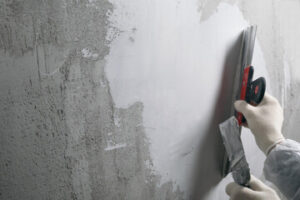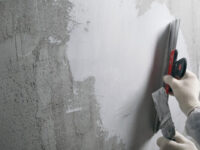Stucco Repair – Homeowners Can Do It Theirself
If a homeowner notices that their stucco is damaged, they may need professional help at Stucco Repair Charleston SC. However, if the repair is simple enough such as fixing cracks or filling in holes, homeowners can do it themselves.
Start by determining the cause of the damage. This will help determine what needs to be done.
If your home has been constructed with stucco, the occasional crack may be inevitable. It’s important to have them repaired promptly so they do not worsen. It’s also important to prevent future cracking by repairing any structural damage, making sure that vegetation is kept away from the house and painting regularly.
The most common type of crack is a hairline crack. These cracks are thin and usually harmless. They occur when plaster settles or due to construction work. These types of cracks can be fixed by applying a paintable sealant over them. This will allow the crack to expand and contract with temperature changes without further damage to your home.
A larger crack should be addressed by a professional. These cracks can be more serious and could indicate structural issues with your home. They could be caused by foundational movement, a shift in the earth beneath your home or even seismic activity. The best way to determine the severity of a crack is to consult with a stucco professional.
Depending on the severity of the crack, there are several ways to repair it. For smaller cracks, the best method is to apply a caulk to the area. The type of caulk should be chosen based on the texture of your stucco. For example, a sanded caulk would be better for rougher stucco textures than a smooth caulk. It’s important to ensure that the caulk blends in well with the surrounding stucco to avoid a patchy appearance.
Another option is to skim coat the area. This is a great solution for larger cracks and can be used to address hairline cracks as well. This will allow the area to expand and contract with temperature changes without further damaging your stucco. Using a trowel, carefully match the texture of your existing stucco and feather the edges so the transition is as seamless as possible.
For deeper cracks, the technique is a little different. The cracks must be undercut first. To undercut, use a cold chisel to widen the bottom of the crack. Be careful not to chip away too much of the existing stucco, as you will need this lath for the new plaster. Then brush the prepared crack well with bonding liquid. This will help the new stucco to adhere. Then press into the wet caulk some coarse sand or fine gravel. This will stick to the wet caulk surface and be invisible when painted.
Loose Lath
A stucco patch that’s loose or falling away requires a full restoration process including replacing the damaged lath, building paper and applying three coats of stucco repair mix. Major repairs like this are usually best left to a licensed contractor or stucco professional who does this work every day.
Stucco deterioration is typically caused by water infiltration into the wall system. Water infiltration causes wood lath and nails to rot and metal lath and nails to corrode, which creates areas of weakness in the stucco. Depending on the severity of the problem, there may be damage to framing members or insulation. In addition to water, problems are also often caused by improper mortar mixing, bad installation, house settlement, and weather.
The first step in repairing loose or falling stucco is to determine why the stucco failed. A visual inspection should be made and, if the problem is due to moisture, water penetration testing should be performed. A jackhammer or a cold chisel should be used to carefully remove the loose material, being careful not to disturb surrounding intact areas of stucco. Then the condition of the lath should be determined.
Wood lath must be re-attached, and if it is rotten or deteriorating, it must be replaced with new wood lath or expanded metal lath, unless authenticity is important. If the area being repaired is large, it may be necessary to nail new furring strips to the existing lintel and window frame sills. Then, plywood that has been cut to fit should be stapled over the furring strips and galvanized wire mesh attached. The mesh will act as lath for the new stucco.
A small test sample should be taken to verify the type of stucco being used, i.e., lime or Portland cement. A small amount of muriatic acid can be used to separate the two types; lime stucco dissolves in muriatic acid and Portland cement does not. Then the correct type of stucco repair mix can be purchased and mixed. When mixing, always wear gloves and goggles. Muriatic acid is highly corrosive and can burn skin and eyes.
Water Penetration
Water penetration is a common problem that can affect stucco. While it may seem like a minor issue, this kind of damage can lead to serious and expensive problems. The best way to prevent water penetration is by keeping up with stucco maintenance. This includes having it inspected regularly by a professional so that any issues can be fixed quickly before they escalate.
The most obvious sign that water has penetrated stucco is when it appears wet after rainy weather. If you notice wet spots on your stucco that never dry, this is a clear indicator that water is getting into the wall cavity and causing structural damage.
Other signs of moisture in the stucco are cracking or bubbling. If you see any of these signs, call a professional immediately to have your stucco repaired. It’s also important to check the drywall behind your windows for any water damage. If the drywall feels soft or spongy, this is another indication that moisture has made its way into your walls.
Stucco, exterior insulation finishing systems (EIFS), concrete, and masonry are all susceptible to cracking due to climate changes. If these cracks allow moisture to reach the underlying sheathing or framing, this can lead to wood rot and a host of other issues.
Moisture that is allowed to remain trapped within a stucco wall can also create an environment for mold and mildew growth. These fungal organisms can affect indoor air quality and lead to health issues for home occupants. Moisture can also damage underlying insulation and sheathing, leading to costly repairs and replacement.
Water intrusion in stucco walls can also have an effect on the value of your property. Many prospective buyers may not want to buy a home with extensive water damage to the stucco.
One of the most effective ways to keep water out of your stucco is by using a waterproof barrier. This can be applied to the interior of the walls, or it can be installed in the form of a drip edge. This will help to protect your home from the damaging effects of water intrusion, and it can be installed over existing stucco.
Damages
Stucco can be damaged in a variety of ways. One of the most common problems is stains from water or other substances that seep through the surface. This can be caused by leaking windows, cracking stucco, or even rotted wood. If a problem like this occurs, it is important to get it fixed quickly so that it doesn’t worsen over time.
Another way that stucco can be damaged is through the sun’s rays, which can cause fading and discoloring. This can be easily repaired by applying a new coat of stucco paint.
If your stucco is showing signs of damage, it’s important to have it inspected and repaired by a professional. Not only will this prevent further damage to the structure of your home, but it can also help restore its aesthetic appeal and value. Stucco repair can be relatively inexpensive and will often be covered by homeowner’s insurance.
Cracks in stucco are usually the result of poor installation, but they can also be a sign of other issues that need to be addressed. Cracks that are larger than a quarter of an inch should be considered serious and should be remedied as soon as possible to prevent further damage.
Other warning signs of stucco damage include leaking through the ceiling and walls of your home. This is a sign that moisture has gotten into or under the stucco, which can lead to wood rot, mold, and other structural problems.
Leaking through a stucco wall is almost always caused by water penetration. The best way to avoid this type of problem is by installing gutters on your house, which will direct rainfall away from the stucco and into a drainage system. Another way to keep water out of your home is by using a stucco coating that includes a built-in waterproofing system. This will keep moisture and other contaminants out of your walls and ceilings. If you do end up with a water leak, it’s a good idea to hire a contractor who specializes in stucco remediation. They can assess the damage and work with your homeowners insurance company to get you compensation for your losses.





